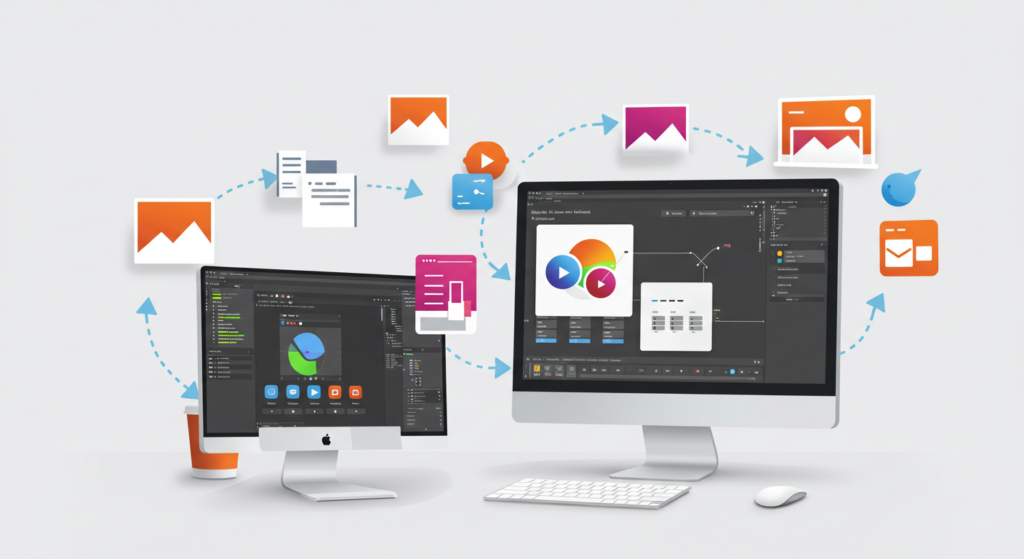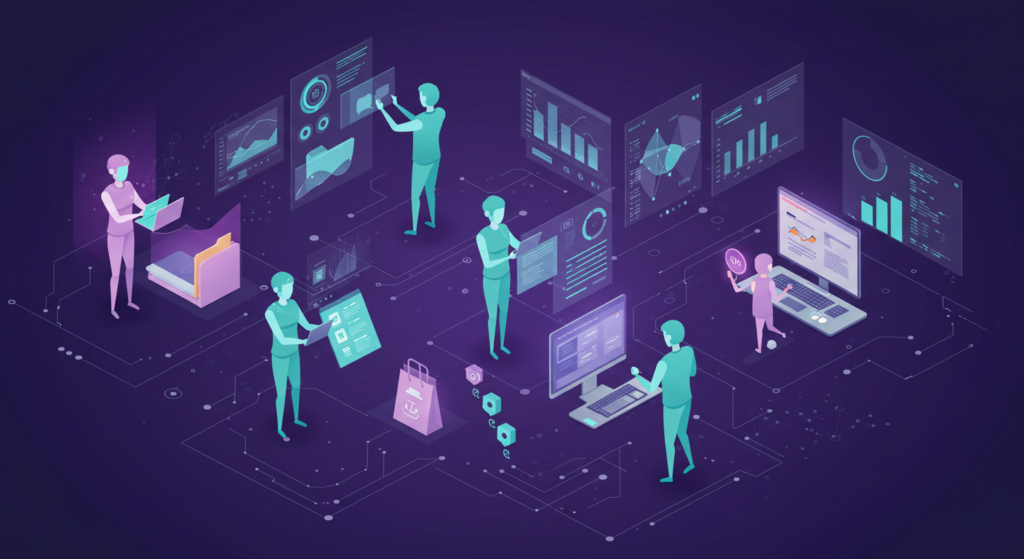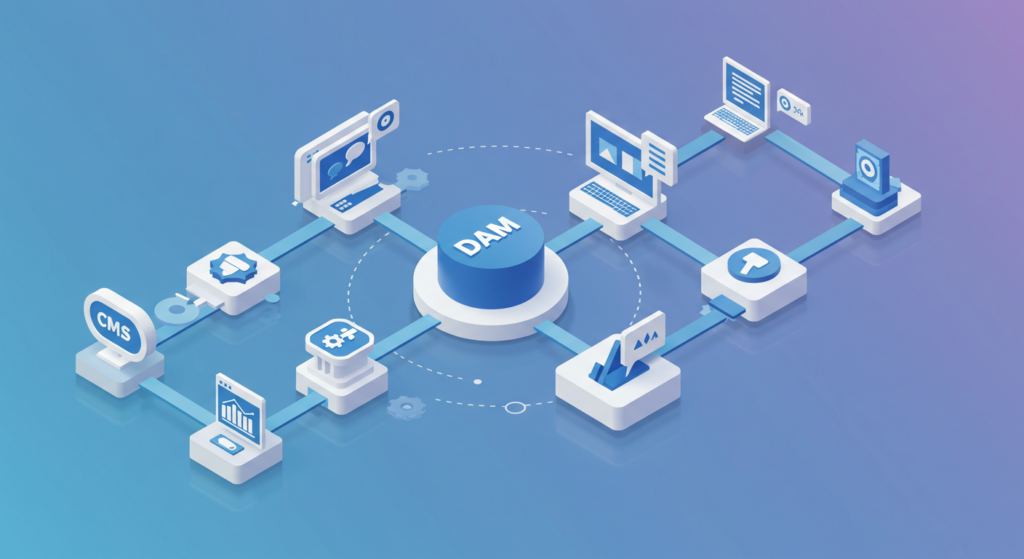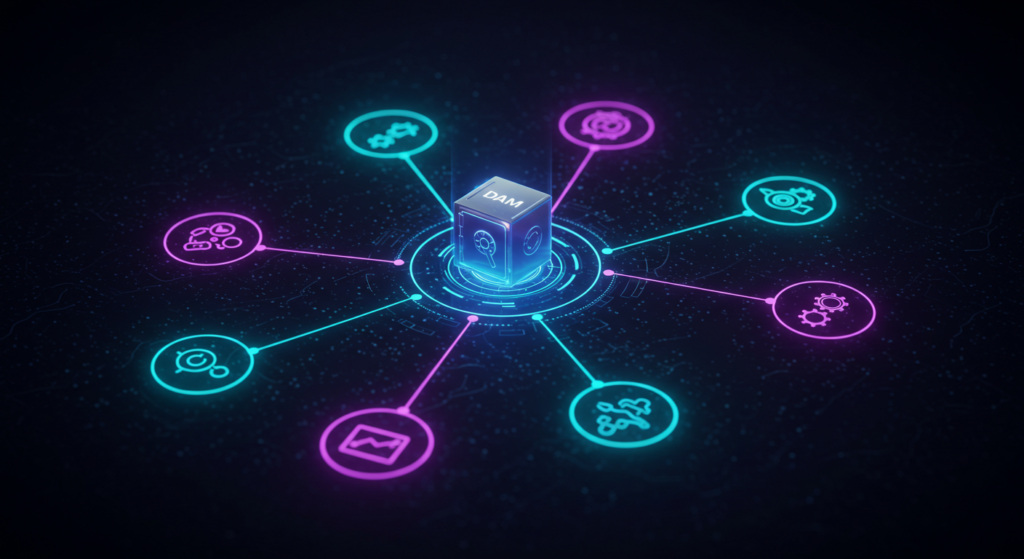The modern marketing landscape demands seamless connectivity between your digital asset management (DAM) system and the broader technology ecosystem that powers your content operations. Recent research shows that creative and marketing leaders prioritize DAM integrations with creative toolkits, web CMS, and project management software as their top three connection points, but the integration landscape has evolved significantly beyond these basics.
Digital asset management integrations have become the backbone of efficient content operations, enabling teams to access, transform, and distribute approved assets without constantly switching between platforms. Integrations allow users to access and use digital assets directly within their existing workflows, eliminating the need to switch between platforms.
Teams that fail to establish robust DAM integrations face mounting challenges: fragmented workflows, version control issues, compliance risks, and the constant drain of manual asset management tasks that could otherwise be automated.
Why Digital Asset Management Integrations Matter More Than Ever
Content operations have reached a tipping point. Marketing teams are producing more assets across more channels while facing pressure to maintain brand consistency, ensure compliance, and demonstrate measurable ROI from their creative investments.
In addition to centralizing, organizing, streamlining, categorizing, and storing the entirety of an organization’s media assets, an integrated digital asset management platform provides a comprehensive marketing system solution that connects every aspect of the content lifecycle. When properly implemented, these integrations eliminate information silos, reduce human error, and create automated workflows that scale with business growth.
The most successful content operations teams understand that their DAM system serves as the central nervous system connecting all other marketing technologies. This integration-first approach enables what industry leaders call “intelligent content operations,” where AI-powered automation, seamless asset distribution, and real-time performance optimization work together to drive unprecedented efficiency and results.
The 8 Essential DAM Integrations for 2025
1. Creative Tools and Design Platforms
The foundation of any digital asset management integrations strategy starts with creative tools. Integrating DAM software with design tools like Figma and Adobe Creative Cloud makes it easier for creative teams to work with the assets and brand elements in your DAM.

Key Integration Benefits:
- Direct access to brand-approved assets within creative applications
- Automated asset check-in and version control
- Real-time collaboration on creative projects
- Streamlined approval workflows
Popular Creative Tool Integrations:
- Adobe Creative Cloud (Photoshop, InDesign, Illustrator, Premiere Pro)
- Figma and collaborative design platforms
- Canva for template-based content creation
- Video editing suites for multimedia content
Modern creative teams no longer have time for the traditional download-edit-upload cycle. Creative tool integrations enable designers to pull approved assets directly into their workflows while maintaining automatic version control and brand compliance checks.
2. Content Management Systems (CMS) and Web Publishing
Connecting a DAM platform with a CMS like WordPress, Webflow, or Drupal means teams can directly access brand content and approved assets for publishing on web pages without switching between tools. This integration category has evolved beyond basic file sharing to include advanced features like automated asset optimization and dynamic content delivery.
Advanced CMS Integration Features:
- Automatic image optimization for web performance
- Dynamic asset transformations based on page context
- SEO-optimized alt text and metadata insertion
- Real-time asset updates across all web properties
Leading CMS Platforms with DAM Integration:
- WordPress and headless CMS solutions
- Drupal for enterprise content management
- Webflow for design-centric publishing
- Optimizely for experience optimization
Users can pull digital assets stored in the DAM and use them directly within the CMS, ensuring brand consistency and reactive content publishing. This seamless connection eliminates the risk of outdated assets appearing on your website while dramatically reducing the time required for content updates.
3. Marketing Automation and CRM Platforms
The integration between digital asset management systems and marketing automation platforms represents one of the most impactful connections in modern content operations. Marketing teams can centralize all media assets and deliver them to any customer touchpoint, such as email, landing pages, subscription forms, and more.
Strategic Marketing Automation Benefits:
- Personalized content delivery at scale
- Automated campaign asset selection based on audience segments
- Real-time performance tracking and optimization
- Cross-channel brand consistency enforcement
Essential Marketing Platform Integrations:
- Salesforce Marketing Cloud for enterprise email marketing
- HubSpot for inbound marketing automation
- Marketo for lead-nurturing campaigns
- Pardot for B2B marketing workflows
These integrations enable what industry experts call “intelligent asset decisioning,” where AI algorithms automatically select the most effective assets for specific audience segments, dramatically improving campaign performance while reducing manual workload.
4. E-commerce and Product Information Management (PIM)
Integrating with a Product Information Management (PIM) system is becoming increasingly important. Lifestyle videos and images are essential for e-commerce products, and a DAM system is central to driving those content experiences. This integration category has become critical as brands seek to deliver consistent product experiences across all touchpoints.
E-commerce Integration Capabilities:
- Automatic product image optimization for different channels
- Dynamic pricing and promotional overlay generation
- Multi-variant product visualization
- Automated product content localization
Key PIM and E-commerce Platforms:
- inRiver for comprehensive product information management
- Shopify for direct-to-consumer e-commerce
- BigCommerce for enterprise retail operations
- Akeneo for product experience management
Advanced digital asset management integrations with PIM systems enable what’s known as “product content orchestration,” where product information automatically flows between systems to create consistent, accurate, and compelling product experiences across every channel.
5. AI-Powered Automation and Intelligent Workflows
The most significant advancement in DAM integrations involves AI-powered automation that transforms how teams create, manage, and optimize content. AI Agents represent the cutting edge of this evolution, offering specialized automation for different aspects of content operations.

AI Agents Integration Benefits:
- Planning Agents: Automate campaign and content planning workflows, generating briefs and creative strategies from brand and performance data
- Librarian Agents: Automatically enrich and organize content using predictive metadata, smart captions, and brand-trained tagging models
- Critic Agents: Evaluate creative content subjectively to detect quality issues and recommend optimization changes
- Compliance Agents: Review content for brand and legal risks, automatically flagging non-compliant materials
- Production Agents: Generate, adapt, and localize content using smart automations trained on your brand
These AI-powered integrations represent a fundamental shift from reactive to proactive content operations, where intelligent systems anticipate needs and automate complex workflows that previously required extensive manual intervention.
6. Social Media and Video Distribution Platforms
DAM tools have robust native integrations or connect with Zapier, so you can use them regardless of your tech stack. Over 80% of marketers agree that social media is an essential channel for increasing brand exposure. Social media integration has become essential as brands manage content across an ever-expanding array of platforms, each with unique formatting requirements and optimization needs.
Social Media Integration Features:
- Platform-specific asset optimization and formatting
- Automated posting and scheduling workflows
- Cross-platform performance tracking and analytics
- Brand-safe content approval processes
Popular Social and Video Platforms:
- YouTube for video content distribution
- LinkedIn for B2B content marketing
- Instagram and TikTok for visual storytelling
- Twitter/X for real-time engagement
Modern social media integrations include AI-powered content adaptation that automatically creates platform-optimized versions of your assets while maintaining brand consistency across all channels.
7. Analytics and Performance Tracking Integration
By pumping rich, personalized content out across all customer-facing channels, internal workflows and processes will be able to deliver more ROI. Analytics integration enables data-driven content strategy by connecting asset performance directly back to business outcomes.
Advanced Analytics Capabilities:
- Asset performance tracking across all channels
- ROI measurement for content investments
- Predictive analytics for content optimization
- Real-time engagement monitoring and alerting
Key Analytics and BI Platforms:
- Google Analytics for web performance tracking
- Adobe Analytics for enterprise measurement
- Tableau for advanced data visualization
- Custom BI solutions for specialized reporting
These integrations enable “closed-loop content optimization,” where performance data automatically informs future content creation and distribution decisions, creating a continuous improvement cycle that maximizes content ROI.
8. Collaboration and Project Management Systems
The final essential category focuses on workflow orchestration and team collaboration. By connecting DAM with project management and collaboration tools, team members can easily share, review, and approve assets, fostering better communication, coordination, and faster decision-making within teams.
Project Management Integration Benefits:
- Streamlined approval workflows and review processes
- Real-time project status tracking and reporting
- Resource allocation and capacity planning
- Cross-functional team collaboration
Leading Collaboration Platforms:
- Slack for real-time team communication
- Microsoft Teams for enterprise collaboration
- Asana for project management and workflow automation
- Monday.com for visual project tracking
These integrations transform content operations from a series of disconnected tasks into a cohesive, optimized workflow that scales with team growth and project complexity.
Implementation Best Practices for Digital Asset Management Integrations
Successful implementation of digital asset management integrations requires strategic planning and careful execution. Start by conducting a comprehensive audit of your existing technology stack to identify integration opportunities and potential challenges.
Prioritize integrations based on their potential impact on your team’s daily workflows. Organizations tend to seek out integrations as a way to optimize and automate workflows, taking stock of the tools they use the most to see how they could extend the benefits of all their technology investments.
Consider the long-term scalability of your integration strategy. Choose platforms that offer robust APIs and flexible integration options rather than rigid, point-to-point connections that may become limiting as your needs evolve.

Measuring Success: KPIs for DAM Integrations
Effective measurement of integration success requires tracking both operational metrics and business outcomes. Key performance indicators should include time saved on routine tasks, error reduction in asset management, improved content velocity, and increased asset reuse rates.
Enhanced customer experience through integrating DAM with CRM and marketing automation tools enables personalized and timely content delivery, ensuring consistent branding and improving customer engagement and satisfaction across multiple channels.
Monitor user adoption rates across integrated platforms to ensure your team is realizing the full benefits of your integration investments. Regular assessment and optimization of integration performance ensures continued value delivery as your content operations mature.
Frequently Asked Questions
What are the most important digital asset management integrations for getting started?
The essential starting point for most organizations includes creative tool integrations (Adobe Creative Cloud, Figma), CMS connections (WordPress, headless CMS), and basic marketing automation platforms (HubSpot, Salesforce). These three categories cover the majority of daily workflows for most content teams.
How do DAM integrations improve ROI?
Digital asset management integrations improve ROI by reducing manual work, eliminating duplicate content creation, ensuring brand consistency, and enabling data-driven optimization. Teams typically see time savings on routine asset management tasks within the first six months of implementation.
Can small businesses benefit from advanced DAM integrations?
Absolutely. While enterprise organizations have more complex needs, small businesses often see proportionally greater benefits from digital asset management integrations due to limited resources. Cloud-based solutions and SaaS integrations make advanced functionality accessible regardless of organization size.
What should I consider when choosing between native and third-party integrations?
Native integrations typically offer deeper functionality and better long-term support, while third-party solutions provide flexibility and faster implementation. Consider factors like long-term strategic importance, required functionality depth, and available technical resources when making this decision.
How long does it typically take to implement comprehensive integrations?
Implementation timelines vary significantly based on complexity and organizational readiness. Basic integrations can often be completed in 2–4 weeks, while comprehensive multi-platform integration strategies may require 3–6 months for full implementation and optimization.
What role does AI play in modern DAM integrations?
AI transforms digital asset management integrations from simple connectivity into intelligent automation. Modern AI capabilities include predictive metadata generation, automated content optimization, intelligent asset recommendations, and proactive quality control. These aspects fundamentally change how teams interact with their content operations technology.
Building Your Future-Ready Content Operations
The key to success lies in viewing digital asset management integrations not as isolated technical connections but as the foundation for intelligent, automated content operations that drive measurable business results. When properly implemented, these integrations transform content from a cost center into a strategic growth driver that delivers consistent value across every customer touchpoint. Discover how Aprimo’s comprehensive platform can streamline your workflows, improve collaboration, and drive measurable ROI from your content investments.


